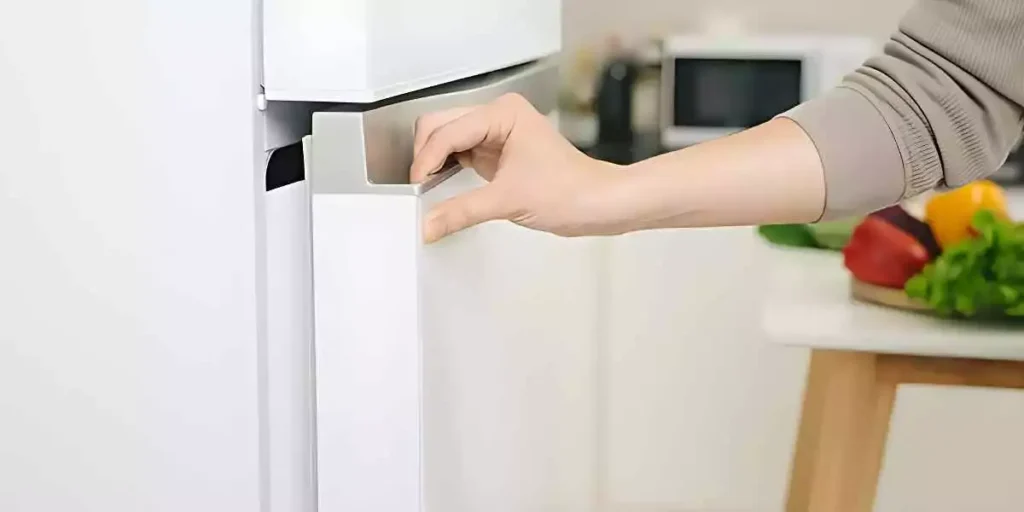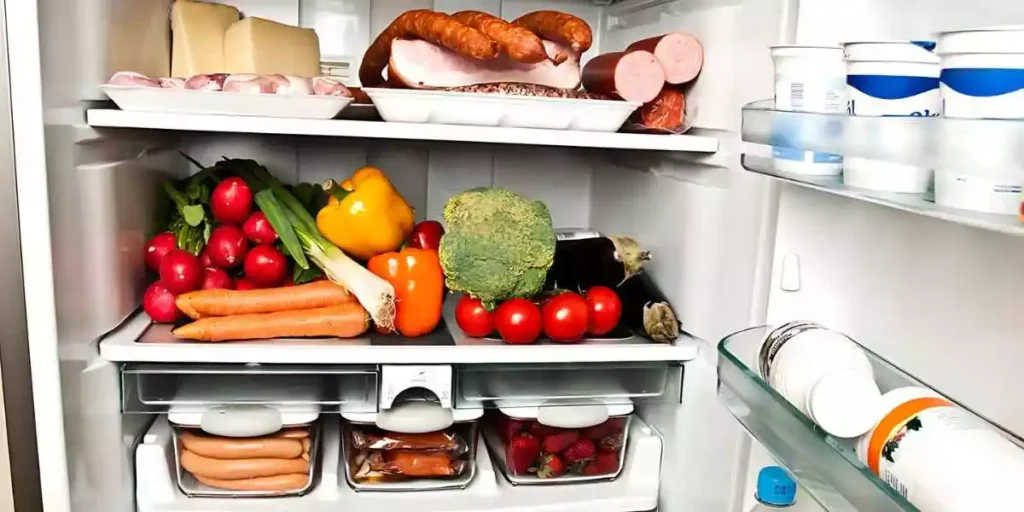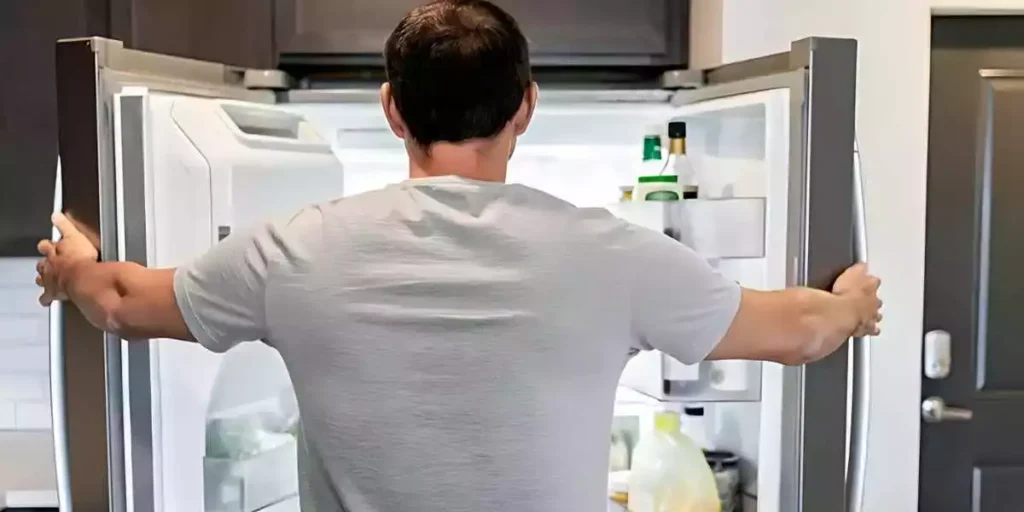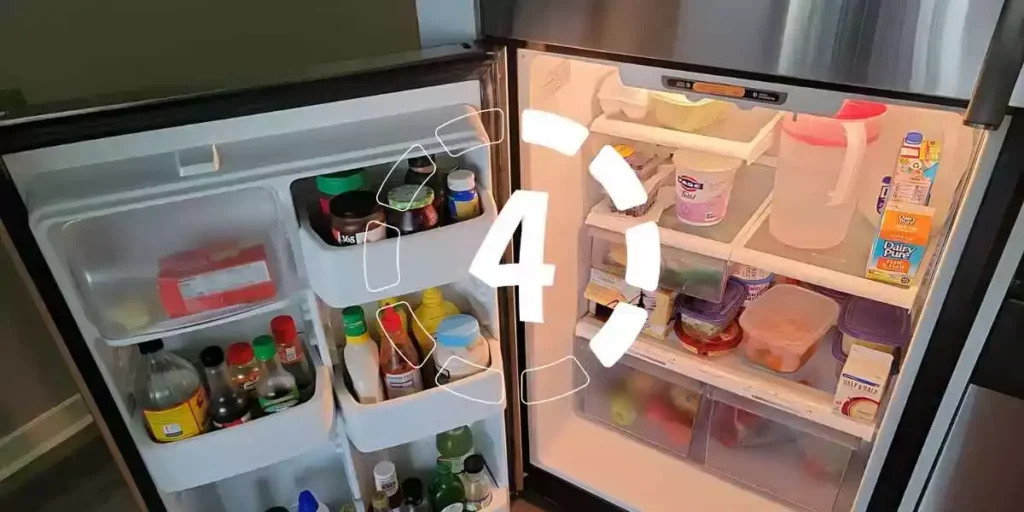Ever wondered what happens when you leave the fridge door open for hours? Get ready to unravel the secrets behind food preservation.
We’ll uncover the science of temperature, spoilage, and how to keep your fridge happy. We’re also going to crack the case of the open fridge door.

Fridge Door Left Open For 4 Hours
To keep your food safe, close the fridge door immediately. Check the temperature inside the fridge; As long as the temperature inside stays below 40 degrees Fahrenheit, the food is still safe to eat.
Bacteria grow rapidly between 40 and 140 degrees Fahrenheit, so if the temperature remains low, the food won’t spoil.
However, if you’re unsure, it’s better to be cautious and throw it out.
7 Potential Risks Of Leaving The Fridge Door Open
1. Power Consumption Surges
One might believe that leaving the fridge door open for a few minutes doesn’t have a significant impact on energy consumption. But the reality is quite the opposite.
The fridge operates by maintaining a lower temperature inside than your room temperature.
When you leave the door open, the cold air escapes and warmer air from the room enters.
The fridge then has to kick into overdrive to restore the interior temperature, consuming more electricity than usual.
In the long run, this pattern can lead to higher electricity bills than expected.
2. Spoilage of Food

An open fridge door does more than just waste energy; it can also ruin the food inside. The refrigerator maintains a specific temperature to preserve your food.
When warm air floods in, it changes this temperature. Foods, especially dairy, and meat, can begin to spoil faster under these conditions.
Imagine the waste of finding your groceries unfit for consumption because of a carelessly left open door.
3. Growth of Harmful Bacteria
Certain bacteria and other microbes thrive in warmer conditions. The temperature rises when the refrigerator door is left open, creating a suitable environment for these harmful organisms.
They can multiply rapidly in your food, posing potential health risks. From mild food poisoning to severe stomach infections, the consequences can be unpleasant and harmful.
4. Impact on Fridge’s Longevity
Fridges, like other appliances, have a finite lifespan. When forced to work harder to maintain the interior temperature, the fridge undergoes unnecessary strain.
This added stress can lead to a faster deterioration of its components, shortening its lifespan.
In the worst case, you may need to replace your fridge earlier than anticipated, which is a substantial cost.
5. Wasting Natural Resources
We often forget that our power usage has a direct impact on our environment.
The extra energy your fridge consumes contributes to higher demands on power plants, most of which rely on burning fossil fuels.
These fuels, besides being finite, release harmful greenhouse gases when burnt.
Thus, something as small as leaving the fridge door open can add to environmental pollution and the depletion of Earth’s natural resources.
6. Risk of Accidents

While it might not seem like a big deal, an open fridge door can also be a safety hazard. Especially in households with young children or pets, an open door can lead to accidents.
Imagine your toddler running full speed into the open door or your pet knocking over items on the door shelves. By keeping the fridge door closed, you avoid these potential mishaps.
7. Unpleasant Odor
An open fridge isn’t just an energy or safety concern; it can also become a nuisance.
Foods with strong smells, such as fish or certain types of cheese, can make your entire kitchen or even your home smell unpleasant.
By keeping the door closed, you contain these odors within the fridge, maintaining a fresh atmosphere in your kitchen.
How To Prevent Accidental Fridge Door Openings
Place Fridge Wisely
Your fridge’s location plays a critical role in its functionality. High-traffic areas, like next to doors or windows, increase the chance of accidental bumps.
Those can lead to unintended fridge openings.
Furthermore, exposure to direct sunlight heats the fridge up, making it work harder. As a result, it’s best to place your fridge in a quiet, cool corner.
Keep Fridge Level
A tilted fridge can cause the door to swing open. When the fridge isn’t level, it affects the door’s ability to shut correctly.
Using a carpenter’s level, check if the fridge is balanced on all sides.
If you see any unevenness, adjust the fridge’s feet until the bubble in the level is centered. This simple check can save you from frequently finding your fridge door ajar.
Maintain Door Seals
Door seals, or gaskets, are the soft, rubbery strips lining the door’s edge. Their purpose is to create an airtight seal when the door is closed.
Over time, debris and spills can wear them down, weakening their grip. This wear can result in the fridge door not closing securely.
So, cleaning these seals with warm, soapy water and a soft cloth should be a regular part of your kitchen routine.
If the seals look damaged or worn out, replace them to ensure your fridge door stays shut.
Check Door’s Closing Force

Fridge doors are designed to shut securely by themselves when left halfway open. This design feature relies on the tension in the door’s hinges.
If your fridge door isn’t closing by itself, you may need to increase the hinge tension.
Most fridges allow you to do this by tightening screws located either on the hinges or the top of the fridge.
Organize Fridge Contents
Overstuffing the fridge, particularly the door shelves might cause the door to pop open. These shelves are designed for lightweight items, like condiments and drinks.
Putting heavier items can tip the balance, causing the door to swing open. Regularly rearrange items in your fridge, ensuring the heaviest ones are at the bottom and in the back.
Use Child Safety Locks
If you have curious little ones at home, they might enjoy opening the fridge and forget to close it. Installing child safety locks can be an effective solution.
These locks are simple devices that stick to your fridge, keeping the door securely closed.
It’s an easy-to-install solution that prevents your kids from leaving the fridge door open.
Install Door Alarms
A door alarm serves as an excellent reminder to close the fridge door. This device emits a beep when the door is left open for a certain period.
Modern fridges come with built-in door alarms. If your fridge doesn’t have one, standalone door alarms are available.
Handle Door with Care

Properly handling the fridge door ensures its mechanisms remain undamaged.
Forcefully opening or closing the fridge door can lead to wear and tear over time.
This wear can affect the door’s alignment and balance, resulting in unintended openings.
Always handle your fridge door with care, teaching other household members to do the same.
Steps To Assess Food Safety After Leaving The Fridge Door Open
Checking the Temperature
First up, measure the inside temperature. For this, you need a refrigerator thermometer.
Set it inside and close the door. Wait for half an hour. It gives the thermometer ample time to settle and provides an accurate reading.
The goal is to see if the temperature is 40°F or below. This range ensures food safety.
However, a higher temperature can mean your food might be unsafe. If so, it’s time to examine the items inside individually.
Smelling the Food
Your sense of smell plays an essential role in food safety. Open your food containers and give them a good sniff.
Fresh food has a characteristic smell, whereas spoiled food often gives off a strange or unpleasant odor.
Trust your instincts here. Eating isn’t safe if you think something doesn’t smell right.
Feeling the Food

Another step in assessing food safety is touching your food. Carefully pick up food items and feel their temperature.
If they are warm, it’s a warning sign. Foods that are still cold or cool to the touch are more likely to be safe.
But any warm food might have been in the ‘danger zone’ (above 40°F and below 140°F) where bacteria thrive.
Examining Dairy Products
Dairy products are highly perishable. When assessing food safety, give special attention to dairy items like milk, cheese, and yogurt.
Smell these items and look for visual changes. If the milk smells sour or the cheese has visible mold, they must be discarded.
Investigating the Meat
Meat is another food category that deserves extra scrutiny. Check the color of the meat. It should retain its normal color.
Any changes in color or a foul smell are indicators that it may have spoiled. As meat spoils quickly in warm conditions when in doubt, it’s better to throw it out.
Scanning Fruits and Veggies
Fruits and vegetables can also spoil in warm temperatures. Check them for signs of spoilage like mold, slime, or a bad smell.
Feel them too. Fresh fruits and veggies should be firm, not soft or mushy. Discard any that show signs of spoilage.
Surveying the Condiments
Condiments like ketchup, mustard, and mayonnaise usually last longer than other foods. However, they should also be checked.
Open the containers and give them a sniff. If they smell fine, they are likely safe to eat. If not, throw them away.
Taking Note of Time

The duration for which the refrigerator door was open matters. Food safety becomes a real concern if it’s been more than four hours.
Many food items can enter the ‘danger zone’ at this time, potentially spoiling. However, if it was less than four hours, chances are most items are still safe.
Using Ice Packs
A smart strategy is using ice packs. Placing ice packs next to food can help if you find the fridge door open.
It keeps the temperature down, reducing the chance of food entering the ‘danger zone.’ It’s a handy trick when you catch the open fridge early.
FAQs
How Can I Tell If The Food In The Fridge Is Spoiled?
Spoiled food often has a foul odor, unusual texture, or mold growth. Look for signs like a rancid smell, sliminess, discoloration, or visible mold.
If you notice any of these signs in your food, it’s best to err on caution and throw it away.
Can I Still Eat Food In The Fridge With The Door Open?
If the food in your fridge was exposed to warm temperatures for four hours, discarding perishable items like meat, dairy products, or leftovers is safer.
Items such as condiments, unopened jars, or whole fruits and vegetables should be fine as long as they appear fresh and unspoiled.
How Can I Prevent Food Spoilage When Leaving The Fridge Door Open?
To prevent food spoilage, close the fridge door as soon as you realize it’s been left open. Check the temperature inside and adjust it if necessary.
Additionally, ensure good air circulation around the fridge and avoid overcrowding it to maintain proper cooling.
Is There Any Danger To My Fridge If The Door Is Left Open?
Leaving the fridge door open for a few hours shouldn’t cause any immediate danger to the fridge itself.
However, it may increase energy consumption as the appliance works harder to cool the interior. Make sure the fridge door seals properly to maintain its efficiency.
How Can I Save Energy When Using My Refrigerator?
Avoid keeping the door open for extended periods to save energy while using your refrigerator.
Organize your items to minimize the time spent searching for things, and close the door tightly each time you finish using it.
Regularly defrosting your freezer and cleaning the condenser coils can also improve energy efficiency.
Conclusion
Leaving your fridge door open can lead to risks like power surges, food spoilage, harmful bacteria growth, and reduced fridge lifespan.
Prevent accidents by placing the fridge wisely, maintaining seals, and using child safety locks.
Assess food safety by checking temperature, smelling, feeling and examining items.
Stay vigilant to ensure fridge safety and efficiency.

